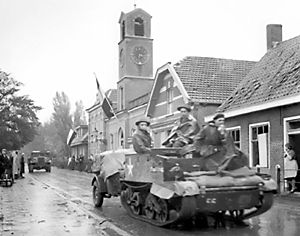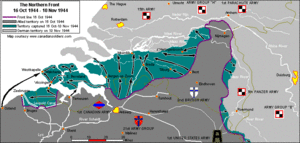Battle of Walcheren Causeway facts for kids
Quick facts for kids Battle of Walcheren Causeway |
|||||||
|---|---|---|---|---|---|---|---|
| Part of Battle of the Scheldt | |||||||
|
|||||||
| Belligerents | |||||||
| Commanders and leaders | |||||||
| Units involved | |||||||
| Strength | |||||||
| unknown | unknown | ||||||
| Casualties and losses | |||||||
| 160 killed & wounded | 60+ killed | ||||||
The Battle of Walcheren Causeway was a tough fight during World War II. It took place in 1944 as part of the larger Battle of the Scheldt. Canadian and British soldiers fought against German forces. This battle happened on and around Walcheren Island. It was one of the first big fights in that area. It was also the second major battle for a specific land feature called the Sloedam.
Contents
Why This Battle Was Important
After the Allies broke out of Normandy in August 1944, German forces held onto many ports. This made it hard for the Allies to get supplies. They had to bring everything from far away. The port city of Antwerp became a very important target.
British forces captured Antwerp on September 4. But they couldn't use the port yet. German forces still controlled the Scheldt River. This river connected Antwerp to the North Sea. The Allies needed to clear the Germans from the river's path.
The Walcheren Causeway: A Key Spot
A narrow strip of land connected Walcheren Island to the mainland. It was called the Sloedam, or Walcheren Causeway. This causeway was very important. It had a railway line and a paved road. These ran from the mainland onto Walcheren Island. They led to the port of Vlissingen.
The causeway was about 40 meters (130 feet) wide. It was also about a kilometer (0.6 miles) long. On both sides, there were marshes and deep water. This made it very hard to move around. The causeway was the only easy way to get to Walcheren Island by land.
Getting Ready for Battle
The Allies needed to use the port of Antwerp. This was key before they could invade Germany. So, the Battle of the Scheldt involved very fierce fighting.
By October 31, 1944, most of the land around the Scheldt River was clear. But German forces still held Walcheren Island. They had powerful coastal guns there. These guns blocked ships from reaching Antwerp. This caused big problems for Allied supplies.
The Allies used RAF Bomber Command planes to bomb the island's sea walls. This happened on October 3 at Westkapelle. Many civilians lost their lives. More bombings happened on October 7 and 11. This caused the middle of the island to flood. The German defenders had to move to higher ground. They gathered in the towns.
Canadian soldiers had moved west along the South Beveland area. By October 31, they had cleared all German resistance. Walcheren Island was connected to South Beveland by the narrow causeway. It was 40 meters wide and 1600 meters long.
Soldiers planned to use small boats to cross the Sloe Channel. But the ground was too muddy for the boats. So, the Calgary Highlanders, who had trained for water crossings, had to attack on land. They went directly over the causeway instead.
The Battle Begins

On October 31, 1944, "C" Company of The Black Watch (Royal Highland Regiment) of Canada tried to rush the causeway. They faced heavy fire and suffered many casualties. During their attack, they found a large crater on the causeway. German engineers had blown it up to stop tanks. Later, Canadians used this crater as a command post.
"B" Company of The Calgary Highlanders moved forward just before midnight. They were also stopped halfway across the causeway.
A new plan was made. Major Bruce McKenzie's "D" Company slowly moved forward. They faced intense gunfire. They reached the west end of the causeway at dawn on November 1. They managed to secure it.
The Germans launched strong and long counter-attacks. They even used flame weapons against the Canadians. At one point, all the Calgary Highlander officers in one company were hurt or killed. The brigade major, George Hees, had to take command of a company.
Company Sergeant Major "Blackie" Laloge of the Calgary Highlanders showed great bravery. He was awarded the Distinguished Conduct Medal. He threw back German hand grenades before they could explode near his men.
On November 2, two platoons of Le Régiment de Maisonneuve took over the small area on Walcheren Island. But they were pushed back onto the causeway. A battalion of Glasgow Highlanders tried to advance. But they also could not expand the area on the island.
What Happened Next
British Commandos from the 4th Commando Brigade landed on Walcheren Island from the sea. They attacked at Flushing and Westkapelle. These landings finally defeated the German defenders. The battle for the causeway itself was very costly. In the end, it turned out to be a distraction.
The 2nd Canadian Infantry Division rested in the first week of November. They moved to the Nijmegen Salient for the winter. The Calgary Highlanders had 64 casualties in three days of fighting. Le Régiment de Maisonneuve had one soldier killed and 10 wounded. The Black Watch had 85 casualties between October 14 and November 1. Most of these happened on the causeway.
Remembering the Battle

- The Calgary Highlanders remember the Battle of Walcheren Causeway every year. They have a parade and a church service. This happens on the Wednesday or weekend closest to the battle's anniversary. People from the local Dutch community in Calgary are often invited. This battle was chosen because it shows the strong determination of the unit.
- A permanent monument was built at the causeway in the 1980s. The causeway itself doesn't look the same anymore. Land on both sides of the old railway has been reclaimed. The Sloe Channel is now farmland. Some old German concrete forts can still be seen.
- In recent years, the monuments were moved. This was because of new rail and road construction. A large monument for French troops from a 1940 battle is now there. It overlooks memorials for the 52nd (Lowland) Division and the 5th Canadian Infantry Brigade. These units fought there in 1944.
- The attack on Walcheren Causeway is shown in the 2020 Dutch movie The Forgotten Battle.
Other Fights in the Area
There was also brief fighting near the causeway in May 1940. This happened during the German invasion of the Netherlands.



